How To Allocate Your Floor Covering Project: A Practical Guide
How To Allocate Your Floor Covering Project: A Practical Guide
Blog Article
Write-Up Developed By-Leach Terkildsen
When you're preparing a flooring project, budgeting isn't nearly picking a number; it has to do with understanding what you really require and the costs entailed. You'll wish to evaluate your specific needs, study various products, and expect unexpected expenses. Think about how aspects like room objective and installment methods can impact your budget. But before you jump in, there are some important information you may overlook that can significantly influence your total expenses. Allow's discover exactly how to navigate these complexities and guarantee your task stays on track.
Assessing Your Floor Covering Needs
Prior to diving right into your floor covering job, it's essential to evaluate your flooring needs. Begin by considering the particular areas where you prepare to install brand-new floor covering. Consider the objective of each room. As an example, bathroom and kitchens require water-resistant materials, while living areas could benefit from comfort and looks.
Next, review the status quo of your floors. Exist any type of architectural concerns, such as uneven surfaces or moisture problems? Dealing with these issues early can save you time and money down the line.
Also, keep in mind of the measurements of each area to determine how much floor covering you'll require.
Do not neglect to consider your way of living. If you have family pets or young children, durability could be your leading priority, while an extra official room may require a glamorous finish. Additionally, consider your design preferences. Do you favor a traditional appearance, or are you drawn to modern designs?
Last but not least, be realistic regarding just how much upkeep you agree to dedicate to. Some materials require more maintenance than others. By recognizing your requirements plainly, you'll be much better furnished to make informed options as you move on with your flooring job.
Estimating Prices and Products
Estimating costs and products is a pivotal step in your flooring project that can significantly affect your general spending plan. Begin by gauging your area precisely to figure out just how much floor covering you'll need. For many materials, you'll discover pricing by square foot, so gather quotes from different providers to obtain a sensible figure.
Next off, take into consideration the type of flooring you desire. Alternatives like hardwood, laminate, tile, or carpeting all featured various rate factors. Research the prices for each and consider any added products like underlayment, adhesive, or transition strips.
Do not fail to remember to consist of tools if you're preparing a DIY setup, as leasing or acquiring tools can include in your costs.
Labor prices are one more important factor to consider. If you're working with experts, get quotes from several service providers to guarantee you're obtaining a reasonable cost. Be clear regarding the scope of job to stay clear of unanticipated fees later.
Finally, it's important to reserve a small percentage of your budget for any unforeseen expenses related to materials. By completely estimating your costs and products ahead of time, you'll set yourself up for a smoother and extra workable flooring project.
Preparation for Hidden Expenditures
Several property owners ignore the covert expenditures that can develop during a floor covering project, which can cause spending plan overruns. To avoid this, you require to prepare for potential added prices.
Initially, think about epoxy floor patio of your existing subfloor. If just click the up coming site damaged or unequal, you'll likely need repair work or progressing, which can include substantially to your general cost.
Next off, think of elimination and disposal charges for your old floor covering. Numerous contractors bill added for this solution, so element that right into your budget plan.
Furthermore, do not forget the costs of underlayment, which might not be included in the initial quote but are essential for an effective setup.
You need to additionally get ready for unanticipated difficulties, such as pipes or electric work if your floor covering project involves relocating fixtures. It's important to set aside at the very least 10-15% of your complete budget for these unforeseen expenses.
Lastly, remember that permits might be needed for sure installments. Always check https://www.nasdaq.com/articles/8-types-of-flooring-2021-03-15 to stay clear of fines or hold-ups.
Final thought
In conclusion, budgeting for your flooring project is crucial for an effective result. By assessing your demands, approximating prices, and preparation for concealed expenditures, you'll prevent shocks and stay on track. Keep in mind to allot a part of your budget for unforeseen expenses and maintain an in-depth break down of your expenses. With cautious preparation and factor to consider, you'll produce a lovely space that satisfies your needs without breaking the financial institution. Satisfied floor covering!
